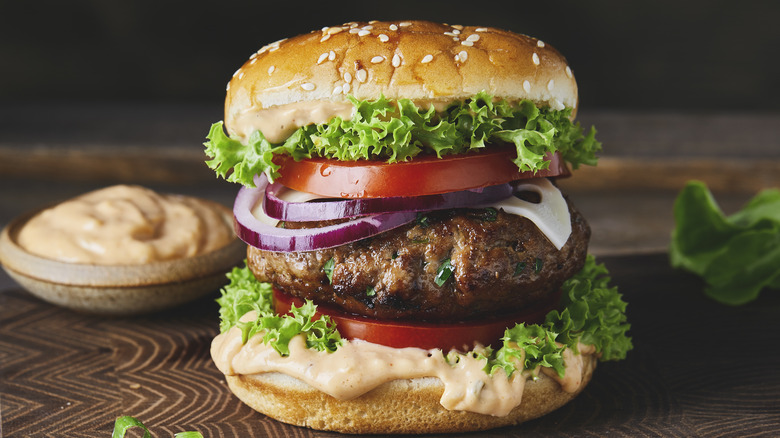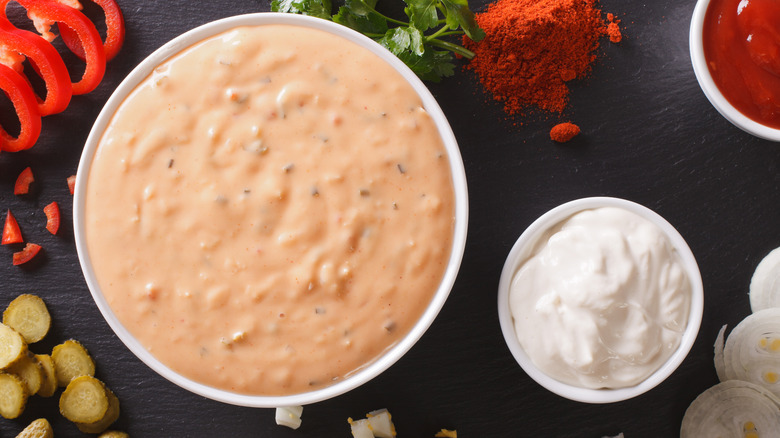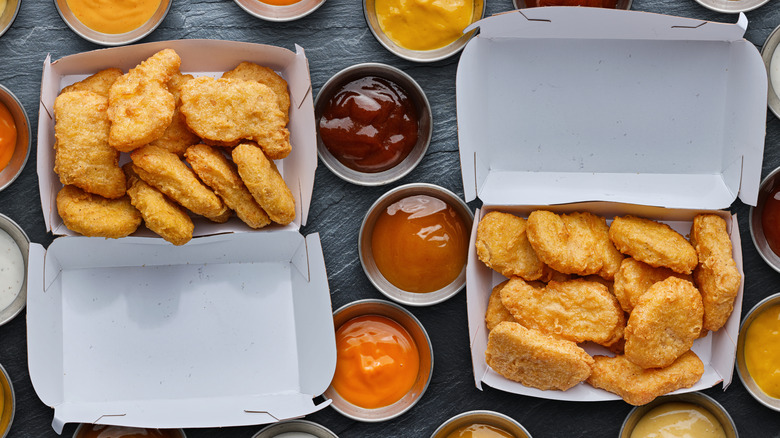The Origin Of Secret Special Sauces At Restaurants
Peruse any restaurant menu sporting American fare, and it's likely they have some kind of secret or special sauce. Slathered on burger buns, squirted in dipping cups, and served alongside steak, special sauces mark a signature flavor supposedly unique to the restaurant. But if those sauces are so special and unique, then why does practically every chain have some version of it? Furthermore, calling a sauce "secret" becomes questionable when so many national and global chains release ingredient lists, and the internet is overflowing with secret-sauce copycat recipes.
While the terms "special sauce" and "secret sauce" are so general that it's impossible to determine an exact origin, cookbooks started mentioning special sauces in the mid-to-late 19th century, with restaurant menus picking up the phrase in the 1940s and '50s. The most famous special sauce of all, in the McDonald's Big Mac, didn't arrive until 1967. Nowadays, it seems like every burger joint or chicken shack has a special sauce, and some condiment brands like Sweet Baby Ray's and Hidden Valley Ranch even sell a secret sauce to use at home.
Most restaurant special sauce blends have a fairly similar flavor profile, using base ingredients along the lines of mayonnaise, some kind of ketchup or tomato paste, acids, aromatics, and sweeteners, so how did we arrive at this commonly replicated flavor? The secret is in the sauce: The quintessential flavors behind many special and secret sauces closely resemble Thousand Island dressing and Russian dressing, but there's more to the mysterious term than renamed classics.
The Thousand Island inspiration behind special sauces
To say that all special sauces are just a dressed-up version of Thousand Island dressing is oversimplifying, and in some cases, flat-out incorrect. It's difficult to know exact recipes due to the secret nature of these sauces, but many well-known restaurants use the same base ingredients: ketchup or tomato paste, mayonnaise or oil and eggs, pickle relish or brine, Worcestershire sauce or molasses and vinegar, garlic, onion, and spices. Coincidentally, or perhaps purposefully, Thousand Island dressing and Russian dressing are much the same.
As far as we know, Thousand Island dressing was invented around the turn of the 20th century, well before special sauces started popping up on restaurant menus, and it's come a long way since its rise to fame at the Waldorf-Astoria hotel in New York City. While there's some debate about the origins of the dressing, its distinctive flavor is an incontestable favorite. Russian dressing may be a bit spicier than its counterpart with an extra kick that comes from the addition of horseradish, but it's alike in preparation.
Perhaps the reason for the dressings' successes and their commonalities with special sauces is that the tangy, savory, slightly sweet flavors are versatile, and pair well with many umami main courses, as well as salty, fried sides. It's unclear whether the majority of restaurant special sauces are intentionally similar to those dressings, but the flavor combinations are certainly delicious both with salads or as a flavor boost for burgers and fries.
Not-so-secret and not-so-special
Contrary to their monikers, most secret and special sauces are neither secret nor special. Several chains freely disclose their special sauce ingredients. Spoiler alert, many are very like the aforementioned dressings: Fast food chain sauces, including Shake Shack's Shack Sauce, In 'N' Out Burger's Spread, Raising Cane's Cane Sauce, Zaxby's Zax Sauce, Red Robin's Campfire Sauce, Carl's Jr. and Hardee's Special Sauce, and Freddy's Famous Fry Sauce, all fall into the Thousand-Island-adjacent category.
Notable exceptions include McDonald's Big Mac Sauce which is made sans ketchup, KFC's KFC sauce which includes Dijon mustard, Jack in the Box's Jack's Secret Sauce featuring added mustard and Tabasco, and Arby's Sauce which comes minus mayonnaise. A few restaurants opt for even more unique recipes, forgoing both the ketchup and mayo bases altogether. Culver's debuted a Signature Sauce of buttermilk ranch, Parmesan, and blue cheese, while the fan favorite, Chick-Fil-A Sauce, combines honey mustard, barbecue sauce, and ranch.
As for the widespread use of the terms "secret sauce" and "special sauce," there's no definitive origin. In-N-Out Burger boasts that its Spread has been made with the same recipe since 1948, establishing it as one of the earliest signature sauces for a chain. But despite debuting its famous condiment 20 years after In-N-Out, McDonald's popularized their version of special sauce with a 1974 Big Mac commercial and jaunty jingle. But even though secret and special sauces are actually neither of those descriptors, the fun names still appeal to us customers and our taste buds.


